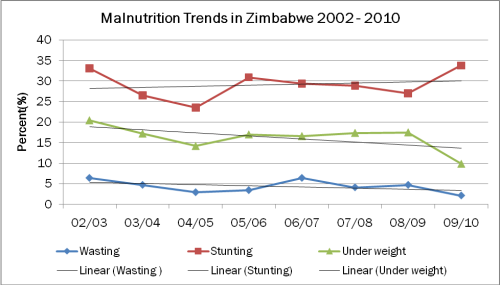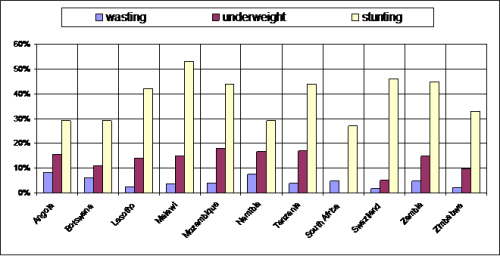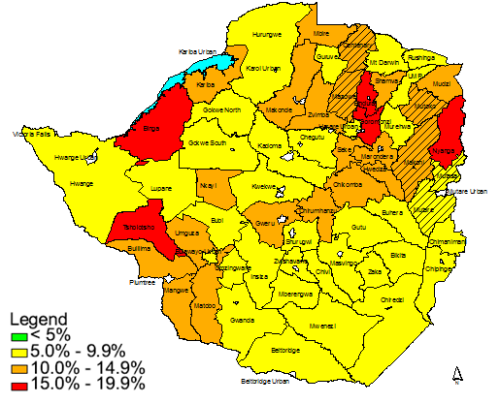What is going on with nutrition in Zimbabwe? Many thought that the economic crisis of the 2000s, combined with land reform, would have resulted in a major decline in nutrition levels in the last decade. This does not seem to have happened. The big question is why?
Many of the international donors clubbed together in 2010 to fund a major nutrition survey across the country, involving a massive sample of around 40000. This complemented earlier surveys carried out on and off since Independence. Over $1m was spent on the survey, but the results were not as some expected (see sources below).
Rather than a dramatic jump in poor nutrition indicators, they actually went down over this period – especially indicators of underweight children (low weight for age, an indicator of both chronic and acute undernutrition) and wasting (low weight for height, an indicator of acute undernutrition). Levels of stunting (low height for age – an indicator of chronic undernutrition) remained constant, but with an increase in recent years, while other indicators declined.
The data is shown in the graph below for the period from 2002, and in the table below for earlier decades (from a WHO database – thanks to Lawrence Haddad for providing this).
| Underweight % | Stunting % | Wasted % | |
| 1980 | 8 | 31 | 1.7 |
| 1994 | 11.7 | 28.9 | 6.3 |
| 1999 | 11.5 | 33.7 | 8.5 |
Aggregate patterns in Zimbabwe are not out of line from the rest of the region. Indeed indicators are somewhat better than other neighbouring countries (see chart below).
Perhaps Zimbabwe’s food crisis was not as bad as some had feared? Perhaps food imports saved the day and avoided mass undernutrition? Perhaps production of food was higher than many had estimated? We don’t know. My suspicion is that, as reported before in this blog, production underestimates are a big part of the story. People moved from reliance on formal supplies to local self-provisioning to avoid any major food shortages. This included informal (illegal) imports, and local sharing, bartering and exchange outside the market.
But why is chronic undernutrition still so prevalent if people are feeding themselves? And why has it increased while other indicators declined? This is yet another puzzle, and no-one seems to know why. Poor absorption of nutrients in the early years is a potential cause of stunting, and some argue that a condition known as ‘tropical enteropathy’ may be part of the explanation. In a 2009 article in the Lancet, Jean Humphrey, working in Zimbabwe, argues that a combination of poor sanitation and poor nutrition can have major effects, resulting in effects on growth, even though nutritional intake remains high (Humphrey, J.H. (2009). Child undernutrition, tropical enteropathy, toilets, and handwashing. The Lancet; vol. 374)
What about the distribution of undernutrition across the country? According to the survey data, underweight children were concentrated in certain districts in 2010 (see map below), but there are no clear reasons why – as these include very low potential areas (e.g. Binga) and some high potential ones too. And other districts, such as in Chiredzi for example, seem to have low levels.
The major donor funded nutrition report did not get much publicity. It didn’t produce the results that were expected, and so did not justify major interventions. But it does raise some important questions and profound puzzles about underlying causes.
The hidden story of nutrition in Zimbabwe – and its complex interactions with sanitation – is one that requires much more research and evidence.
Sources:
Thanks to Blessing Butuamocho and Douglas Magunda for putting me onto this data, and for puzzling together….
ZIMBABWE NUTRITION SURVEY 2010_Draft2:Layout 3.qxd





Pingback: Greatest hits. Your favourite posts in the past year | zimbabweland